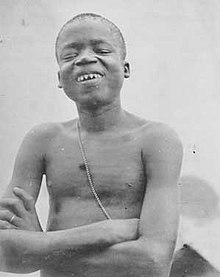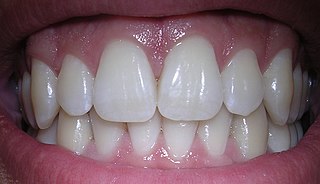
Human teeth function to mechanically break down items of food by cutting and crushing them in preparation for swallowing and digesting. As such, they are considered part of the human digestive system. Humans have four types of teeth: incisors, canines, premolars, and molars, which each have a specific function. The incisors cut the food, the canines tear the food and the molars and premolars crush the food. The roots of teeth are embedded in the maxilla or the mandible and are covered by gums. Teeth are made of multiple tissues of varying density and hardness.
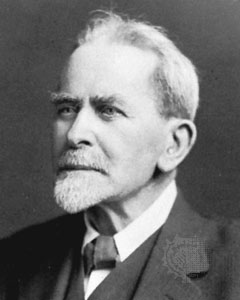
Sir James George Frazer was a Scottish social anthropologist and folklorist influential in the early stages of the modern studies of mythology and comparative religion.
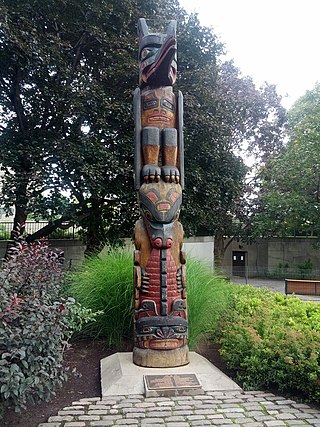
A totem is a spirit being, sacred object, or symbol that serves as an emblem of a group of people, such as a family, clan, lineage, or tribe, such as in the Anishinaabe clan system.

Toothache, also known as dental pain or tooth pain, is pain in the teeth or their supporting structures, caused by dental diseases or pain referred to the teeth by non-dental diseases. When severe it may impact sleep, eating, and other daily activities.

In orthodontics, a malocclusion is a misalignment or incorrect relation between the teeth of the upper and lower dental arches when they approach each other as the jaws close. The English-language term dates from 1864; Edward Angle (1855–1930), the "father of modern orthodontics", popularised it. The word "malocclusion" derives from occlusion, and refers to the manner in which opposing teeth meet.

The pyramid-shaped maxillary sinus is the largest of the paranasal sinuses, located in the maxilla. It drains into the middle meatus of the nose through the semilunar hiatus. It is located to the side of the nasal cavity, and below the orbit.
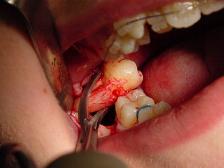
A dental extraction is the removal of teeth from the dental alveolus (socket) in the alveolar bone. Extractions are performed for a wide variety of reasons, but most commonly to remove teeth which have become unrestorable through tooth decay, periodontal disease, or dental trauma, especially when they are associated with toothache. Sometimes impacted wisdom teeth cause recurrent infections of the gum (pericoronitis), and may be removed when other conservative treatments have failed. In orthodontics, if the teeth are crowded, healthy teeth may be extracted to create space so the rest of the teeth can be straightened.

A palatal expander is a device in the field of orthodontics which is used to widen the upper jaw (maxilla) so that the bottom and upper teeth will fit together better. This is a common orthodontic procedure. The use of an expander is most common in children and adolescents 8–18 years of age. It can also be used in adults, although expansion is more uncomfortable and takes longer in adults. A patient who would rather not wait several months for the end result achieved by a palatal expander may be able to opt for a surgical separation of the maxilla. Use of a palatal expander is most often followed by braces to then straighten the teeth.

The maxillary central incisor is a human tooth in the front upper jaw, or maxilla, and is usually the most visible of all teeth in the mouth. It is located mesial to the maxillary lateral incisor. As with all incisors, their function is for shearing or cutting food during mastication (chewing). There is typically a single cusp on each tooth, called an incisal ridge or incisal edge. Formation of these teeth begins at 14 weeks in utero for the deciduous (baby) set and 3–4 months of age for the permanent set.

Mentawai people are the native people of the Mentawai Islands about 100 miles from West Sumatra province, Indonesia. They live a semi-nomadic hunter-gatherer lifestyle in the coastal and rainforest environments of the islands and are also one of the oldest tribes in Indonesia. The Mentawai population is estimated to be about 64,000. The Mentawai tribe is documented to have migrated from Nias – a northern island – to the Mentawai islands, living in an isolated life for centuries until they encountered the Dutch in 1621. The ancestors of the indigenous Mentawai people are believed to have first migrated to the region somewhere between 2000 and 500 BCE. The Mentawai language belongs to the Austronesian language family. They follow their own animist belief system called Arat Sabulungan, that links the supernatural powers of ancestral spirits to the ecology of the rainforest. When the spirits are not treated well or forgotten, they might bring bad luck like illnesses and haunt those who forgot them. Mentawai also have very strong belief towards objects they think are holy. The people are characterized by their heavy spirituality, body art and their tendency to sharpen their teeth, a cultural practice tied to Mentawai beauty ideals. Mentawai tend to live in unison and peace with the nature around them because they believe that all things in nature have a form of spiritual essence.
Maya society concerns the social organization of the Pre-Hispanic Maya, its political structures, and social classes. The Maya people were indigenous to Mexico and Central America and the most dominant people groups of Central America up until the 6th century.

Dental instruments are tools that dental professionals use to provide dental treatment. They include tools to examine, manipulate, treat, restore, and remove teeth and surrounding oral structures.
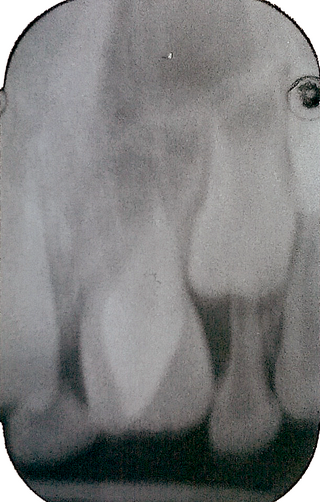
Talon cusp is a rare dental anomaly resulting in an extra cusp or cusp-like projection on an anterior tooth, located on the inside surface of the affected tooth. Sometimes it can also be found on the facial surface of the anterior tooth.
Dental anatomy is a field of anatomy dedicated to the study of human tooth structures. The development, appearance, and classification of teeth fall within its purview. Tooth formation begins before birth, and the teeth's eventual morphology is dictated during this time. Dental anatomy is also a taxonomical science: it is concerned with the naming of teeth and the structures of which they are made, this information serving a practical purpose in dental treatment.

Dental avulsion is the complete displacement of a tooth from its socket in alveolar bone owing to trauma, such as can be caused by a fall, road traffic accident, assault, sports, or occupational injury. Typically, a tooth is held in place by the periodontal ligament, which becomes torn when the tooth is knocked out.

In human anatomy, the mouth is the first portion of the alimentary canal that receives food and produces saliva. The oral mucosa is the mucous membrane epithelium lining the inside of the mouth.
Passion gap or Cape Flats smile is a dental modification originating in Cape Flats, Cape Town, South Africa in which people deliberately remove the upper front teeth for fashion and status. The practice is popular among Coloureds and has occasionally been done by White and Chinese South Africans in the area.
Aztec body modification was practiced by the members of the Aztec Empire in Mesoamerica. Many times the body modification was used in ritual or ceremonial practices. It was also a crucial part of movement between major life stages.
Orthodontic indices are one of the tools that are available for orthodontists to grade and assess malocclusion. Orthodontic indices can be useful for an epidemiologist to analyse prevalence and severity of malocclusion in any population.

Tooth ablation is the deliberate removal of a person's healthy teeth, and has been recorded in a variety of ancient and modern societies around the world. This type of dental modification is visually very striking and immediately obvious to other people from the same or different communities. There are numerous reasons for performing tooth ablation, including group identification, ornamentation, and rites of passage such as coming of age, marriage and mourning. The social meaning of tooth evulsion is likely to remain unknown for ancient populations and may have changed over time within those groups. Dental evulsion can significantly affect the emergence, occlusion and wear patterns of the remaining teeth.
